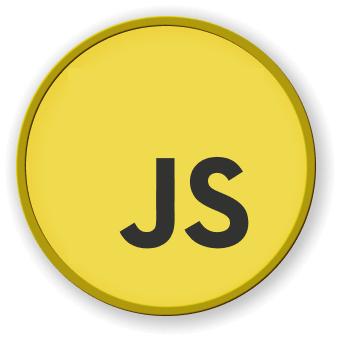Learn JavaScript, the programming language of the web, with this structured learning path. These comprehensive JavaScript courses are tailored for beginners, providing a clear roadmap to master core concepts, DOM manipulation, and asynchronous programming. Develop practical skills for creating dynamic web applications through hands-on, non-video lessons and coding exercises in an interactive JS playground.
TABLE OF CONTENTS
BASIC CONCEPTS
Fundamental concepts in JavaScript programming, covering variables, data types, operators, conditional and loop statements, functions, and basic manipulations of strings, arrays, and objects.
Variables are used to store data values in JavaScript. They are declared using 'var', 'let', or 'const' and can hold various data types such as numbers, strings, and objects.
Data types in JavaScript include numbers, strings, booleans, objects, arrays, and more. Understanding data types is crucial for effective programming.
Arithmetic operators in JavaScript, like +, -, *, /, and %, are used for performing mathematical calculations.
Comparison operators such as ==, ===, !=, >, <, >=, and <= are used to compare values in JavaScript and return boolean results.
Logical operators like && (AND), || (OR), and ! (NOT) are used for combining and negating boolean values in conditional expressions.
Conditional statements, including 'if', 'else if' (elif), and 'else', allow you to execute different blocks of code based on specific conditions.
Switch statements provide a way to select one of many code blocks to be executed based on the value of an expression.
Loops in JavaScript, such as 'for', 'while', and 'do...while', enable repetitive execution of code until a certain condition is met.
Functions are reusable blocks of code that can be defined, called, and passed arguments in JavaScript, allowing for modular programming.
String manipulation involves tasks like concatenation, splitting, and extracting substrings from strings, which are essential for text processing.
JavaScript provides numerous built-in array methods for manipulating arrays, including 'push', 'pop', 'map', 'filter', and 'reduce'.
Object manipulation involves creating, modifying, and accessing object properties, which is fundamental to working with data structures.
ADVANCED CONCEPTS
Advanced JavaScript concepts, including object-oriented programming, asynchronous programming, error handling, closures, ES6 features, and more.
Object-oriented programming (OOP) principles like encapsulation, inheritance, and polymorphism are used to create and manage objects in JavaScript.
Asynchronous programming techniques like callbacks, promises, and async/await are employed to manage non-blocking operations, such as API requests.
Error handling involves using try...catch blocks to handle exceptions and gracefully manage unexpected issues in JavaScript code.
Closures are functions that capture and maintain their surrounding scope's variables, allowing for data encapsulation and privacy.
Higher-order functions are functions that can take other functions as arguments or return them, facilitating functional programming.
JavaScript uses prototypes for object inheritance, allowing objects to inherit properties and methods from other objects.
Destructuring assignment provides a concise way to extract values from objects and arrays and assign them to variables.
Template literals, introduced in ES6, allow for more flexible string interpolation and multiline strings in JavaScript.
ES6 (ECMAScript 2015) introduced various features like arrow functions, let/const declarations, and classes to enhance JavaScript development.
DOM MANIPULATION
Manipulating the Document Object Model (DOM) in web development, covering DOM selection, manipulation, traversal, and event handling.
DOM selection involves selecting HTML elements from a web page using methods like getElementById, querySelector, and getElementsByClassName.
DOM manipulation allows you to modify the content, structure, and style of web pages dynamically using JavaScript.
Event handling is essential for responding to user interactions like clicks and keypresses, enabling interactive web applications.
DOM traversal techniques like traversing parent, child, and sibling elements are used to navigate and manipulate the DOM tree.
TOOLS AND ENVIRONMENT
Tools and concepts related to JavaScript development, including debugging, the Browser Object Model (BOM), web storage, version control, and HTTP requests.
Debugging tools and techniques help identify and fix errors and issues in JavaScript code for smoother development.
The Browser Object Model (BOM) provides access to browser-specific functionalities and properties, allowing interaction with the browser.
Web storage mechanisms like localStorage and sessionStorage enable client-side storage of data for web applications.
Version control systems like Git are used for tracking and managing changes to JavaScript code, enabling collaboration and code history.
NETWORKING
Networking-related topics in JavaScript, including working with JSON data, API interaction, WebSockets, and addressing security concerns like Cross-Site Scripting.
JavaScript can make HTTP requests to fetch data from servers, allowing web applications to interact with external resources.
JavaScript Object Notation (JSON) is a widely used format for data exchange, and JavaScript provides built-in support for parsing and generating JSON data.
Interacting with APIs allows web applications to retrieve and send data to external services, enhancing functionality and data integration.
SECURITY
Security-related topics in JavaScript development, including addressing security concerns like Cross-Site Scripting (XSS) and understanding web security basics.
Cross-Site Scripting (XSS) is a security vulnerability that JavaScript developers need to address to prevent unauthorized code execution on web pages.
Understanding web security basics is essential for safeguarding web applications from common security threats and vulnerabilities.
